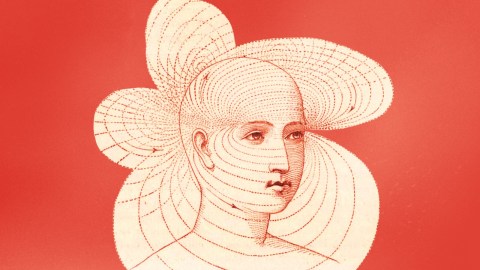3 of the strangest and most puzzling social phobias

- In The Book of Phobias and Manias, Kate Summerscale explores the history of how humans have experienced, categorized, and attempted to treat obsessions and fears.
- Phobias like arachnophobia and claustrophobia affect millions of people around the world, but people can also suffer much rarer phobias, from fearing open spaces to suffering an intense aversion to clusters of holes.
- These three passages from the book cover social phobias: erotomania, erythrophobia, and gelotomania.
EROTOMANIA
Erotomania (from the Greek eros, or passionate love) was originally a term for the deranging desperation of unrequited love; in the eighteenth century it came to mean an excess of sexual desire; and now it describes the delusion that one is secretly adored by another person, a condition also known as de Clérambault’s Syndrome. In 1921 the French psychiatrist Gatian de Clérambault outlined the case of Léa-Anna B, a fifty-three-year-old Parisian milliner who was convinced that George V was in love with her. On her many trips to London, she would stand for hours outside the gates of Buckingham Palace, waiting for the king to send her coded messages with twitches of the royal curtains.
As de Clérambault explained, the heady early days of an erotomaniac fixation often give way to periods of frustration and resentment. The three stages of the syndrome, he said, are hope, vexation and grudge. The condition is assumed to be more common in women, but in men it is more likely to end in violence, either against the imagined lover or against someone who seems to be obstructing the love affair. As a result, male erotomanes are more likely to come to the attention of psychiatrists and the police, and their stories to be recorded.
In 1838, Jean-Étienne Esquirol described a male patient who suffered from this ‘disease of the imagination’, a small, thirty-six-year-old black-haired clerk from southern France, who on a visit to Paris had conceived a great passion for an actress. He waited outside her house in all weathers, hung about at the stage door, followed her on foot when she took a carriage ride, and once climbed onto the roof of a hansom cab in the hope of catching a glimpse of her through a window. The actress’s husband and her friends did their best to discourage him – they ‘revile this wretched man’, wrote Esquirol, ‘repulse, abuse and maltreat him’. But the clerk persisted, convinced that the actress was being prevented from expressing her true feelings for him. ‘Whenever the object of his passion appears upon the stage,’ said Esquirol, ‘he attends the theatre, places himself on the fourth tier of seats opposite the stage, and when this actress appears, waves a white handkerchief to attract her attention.’ And she looked back at him, the clerk claimed, with flushed cheeks and shining eyes.
After a violent altercation with the actress’s husband, the clerk was sent to a mental hospital, where Esquirol interviewed him. Finding that the man was perfectly rational on most subjects, Esquirol tried to reason with him about the actress. ‘How could you believe that she loves you?’ he asked. ‘You have nothing engaging, particularly to an actress. Your person is not handsome, and you possess neither rank nor fortune.’
‘All that is true,’ replied the clerk, ‘but love does not reason, and I have seen too much to doubt that I am loved.’
In London in the 1850s a claim of female erotomania was invoked in the new English divorce court. A prosperous engineer called Henry Robinson filed for a dissolution of his marriage to his wife Isabella in the summer of 1858, submitting her diaries as proof of her adultery with a prominent physician, Dr Edward Lane. Mrs Robinson’s lawyers replied that their client was suffering from erotomania: her diary entries were fantasies, they said, based on the delusion that Dr Lane was in love with her. Isabella Robinson succeeded in defeating her husband’s suit, but her private correspondence suggests that she had done so only to save the young doctor’s reputation. She had pretended to be suffering from erotomania in order to spare her lover.
In some instances of erotomania, the fixations multiply. In 2020 a team of Portuguese psychiatrists outlined the case of Mr X, an unemployed fifty-one-year-old who lived with his widowed mother in a small village in southern Portugal. Mr X became convinced that Mrs A, a married woman who frequented his local coffee house, had fallen in love with him: she sent him signals, he said, and looked at him longingly. He started to follow her around, eventually making such a nuisance of himself that she physically assaulted him. At this, he became convinced that the coffee-shop owner, Mrs B, was also in love with him, and, out of jealousy, had maligned him to Mrs A. He was angry with Mrs A for believing the gossip about him and for not being brave enough to leave her marriage.
Soon afterwards, when his mother fell ill and was moved to a care home, Mr X developed a belief that Mrs C, another coffee-shop regular, had fallen for him. She turned him down when he invited her on a date but he reasoned that, because she was married, she was ashamed of admitting her feelings for him. He began to stalk Mrs C, and at one point accused her of using witchcraft to stop him from sleeping and to shrink his genitals. At knifepoint, he demanded that she undo the spell that she had cast. Mrs C reported the incident, and Mr X was admitted to a psychiatric unit, where he was prescribed antipsychotic drugs. His persecutory delusions abated, but he remained convinced that all three women were in love with him, and declared himself still devoted to Mrs A.
Erotomanes live in a world of their own devising. In Ian McEwan’s novel Enduring Love (1997), the erotomaniac anti-hero is convinced that another man is secretly in love with him. Wherever he looks, he sees hidden messages of desire.
‘His was a world determined from the inside,’ writes McEwan, ‘driven by private necessity … He illuminated the world with his feelings, and the world confirmed him at every turn his feelings took.’
ERYTHROPHOBIA
The word erythrophobia was coined in the late nineteenth century to describe a morbid intolerance for things that are red (erythros means ‘red’ in Greek). Physicians had noticed an aversion to the color in patients whose cataracts had been surgically removed. But by the early twentieth century the word had been adopted to describe a pathological fear of blushing, a dread of going red.
Erythrophobia is a self-fulfilling syndrome, which brings about the physiological change that the sufferer fears. The feeling that one is about to blush summons a blush; as the skin grows hot, the embarrassment intensifies and the heat seems to deepen and spread. The condition can be severely debilitating. In 1846 the German physician Johann Ludwig Casper described a young patient who had started to blush at the age of thirteen and by the time he turned twenty-one was so tormented by the fear of blushing that he avoided even his best friend. That year he took his own life.
People blush when they believe that they are the centre of attention, whether as objects of admiration, ridicule or censure. If others point out that they are blushing, they feel their skin burn all the more furiously. The reddening extends across the area in which the veins are close to the surface of the skin – the cheeks and forehead, the ears, neck and upper chest. The phenomenon is more visible and therefore more likely to become a phobia among fair-skinned people.
Blushing is ‘the most peculiar and most human of all expressions,’ wrote Charles Darwin in 1872; it is induced by ‘shyness, shame and modesty, the essential element in all being self-attention … It is not the simple act of reflecting on our own appearance, but the thinking of what others think of us which excites a blush.’ In fiction, a flush of the skin can reveal a character’s hidden feelings. The literary essayist Mark Axelrod counted sixty-six blushes in Anna Karenina, Leo Tolstoy’s novel of 1878. Anna blushes repeatedly upon hearing the name of her beloved Vronsky. When she and her friend Kitty converse they take turns blushing, as if letting off flares of submission, embarrassment, modesty, pleasure. The rich landowner Konstantin Levin blushes when complimented on his fancy new suit, ‘not as grown-ups blush who hardly notice it themselves, but as boys blush who are aware that their shyness is ridiculous and who therefore feel ashamed of it and blush still more, almost to tears’. He blushes at his blushing. ‘The fear of blushing,’ said the psychiatrist Pierre Janet in 1921, ‘like the fear of exhibiting deformity or a ridiculous aspect of oneself, are varieties of pathological timidity, of the fear to be obliged to show oneself, to speak to others, to expose oneself to social judgments.’ Yet we sometimes blush when we are alone, and sometimes when a private preoccupation is raised in conversation, such as the name of a person to whom we are secretly attracted. The blush here, too, may indicate a fear of exposure; or, as Freudian theorists propose, a desire for such exposure. ‘By blushing,’ wrote the Austrian-American psychoanalyst Edmund Bergler in 1944, ‘the erythrophobe makes himself really conspicuous.’ The wish to be noticed is so strongly repressed, Bergler suggested, that it emerges in the unconscious exhibitionism of the blush.
Biologists have puzzled over the evolutionary purpose of blushing. Some speculate that, as an involuntary response that cannot be faked, it serves a social purpose: by showing that a person is capable of shame and wishes for the group’s approval, the blush works to prevent deception and build trust. Granville Stanley Hall argued in 1914 that all blushing sprang from fear. ‘Its most generic cause,’ he said, ‘seems to be a sudden change, real or fancied, in the way in which others regard us. A too frank compliment, a sense that we have betrayed something we want to conceal and that our give-away would cause censure or criticism.’ Women blush far more than men, he observed, and a ‘blush storm’ could be set off by male attention. ‘To be stared at by men has for ages been for women the prelude to assault,’ he added. ‘Even the blush at compliment may have been because once the sense of being admired was associated with greater danger.’
Many erythrophobes suffer from social phobia. Either they blush because they are pathologically shy, or they fear social interaction because they blush. The Chilean psychiatrist Enrique Jadresic was sure that his blushing had a physiological cause: a chronic blusher has an overactive sympathetic nervous system, Jadresic said, which causes the face and chest quickly to light up. As a university professor, he was mortified by his tendency to redden whenever he unexpectedly met a colleague or student. ‘There you go up the cherry tree again, doctor,’ teased a woman in his department.
Jadresic became exhausted by the need always to be guarding against situations in which he might blush. Having tried several cures, including psychotherapy and medication, he decided to undergo a procedure to cut off the nerve that causes blushing and sweating, which runs from the navel to the neck and can be accessed through the armpit. Many who submit to this operation are afterwards afflicted by pain in the chest and upper back and by compensatory sweating in other parts of the body. Even though Jadresic suffered some of these side-effects himself, he was delighted to be no longer besieged by blushes.
But an experiment reported in the Journal of Abnormal Psychology in 2001 suggested that people who feared blushing might not blush more than others at all. The researchers recruited fifteen socially phobic people who were anxious about blushing, fifteen socially phobic people who were not, and fourteen people without social phobia. Among the erythrophobic subjects was a lawyer who had quit her job because she blushed so much in the courtroom. The researchers asked each participant to watch an embarrassing video (of him or herself singing a nursery rhyme), to hold a five-minute conversation with a stranger and to deliver a short talk. During these tasks an infrared probe would measure the intensity of their blushing and an electrocardiogram would record their heart rates.
To the researchers’ surprise, the erythrophobes did not blush more intensely than either the other socially phobic people or the non-phobic control group. During the conversation task, for instance, the non-phobic participants blushed just as much as the others, but did not report it: they did not notice that their skin had reddened. The erythrophobic group, however, did have higher heart rates than the others during each task. The researchers wondered if a socially phobic person who detected a rise in his or her own heart rate might become instantly and vividly aware of other bodily processes, especially those – like blushing or sweating – that they thought could be perceived by other people. They were so worried about their anxiety being seen that they experienced a fast-beating heart as a fast-heating skin.
GELOTOPHOBIA
Gelotophobia – the fear of being laughed at, from the Greek gelōs, or laughter – is a paranoid, touchy form of social phobia. It was first identified as a clinical condition in 1995 by Michael Titze, a German psychotherapist who noticed that some of his patients were tormented by the feeling that they were being mocked. These patients would mistake a cheery grin for a contemptuous sneer, affectionate teasing for aggressive ridicule. When they heard laughter, their facial muscles congealed, said Titze, producing the ‘petrified countenance of a sphinx’. Some so braced themselves for mockery that they acquired a stiff, jerky gait, and moved like wooden puppets. Titze described their syndrome as ‘Pinocchio complex’. People with gelotophobia often reported having been bullied, Titze found, but it was not clear whether the bullying caused gelotophobia, or whether gelotophobic types interpreted teasing as bullying.
A woman in Titze’s care traced her gelotophobia to her school days. Her mother, a refugee from Eastern Europe, liked to cook with garlic, and the girl found herself being mocked at school because of the smell that emanated from her. A classmate dubbed her ‘Miss Garlike’, and other children joined in the jeering. ‘As soon as they caught sight of me they started grinning in a filthy way,’ said Titze’s patient. ‘Frequently they cried things like, “Ugh!”’ Her schoolmates ostentatiously avoided her, not only in the schoolyard but in the street. ‘Some covered their face with their cap or their schoolbag,’ she said. ‘Everyone facing me with a smiling face caused me to panic.’ She described how her body responded. ‘I grew more and more stiff out of shame.’
Since then, researchers have studied the prevalence of gelotophobia as a personality trait as well as a pathological condition. Willibald Ruch of the University of Zürich has argued that the highest incidence of gelotophobia is found in ‘hierarchically organized societies where the main means of social control is shame’. In one survey, 80 per cent of Thai participants said that they became suspicious if other people laughed in their presence, but fewer than 10 per cent of Finns. Another study found that Chinese students were significantly more afraid of being laughed at than their Indian counterparts. At the International Symposium on Humour and Laughter, held in Barcelona in 2009, Ruch claimed that gelotophobia was most common in British people. ‘Within Europe, Britain is on the top,’ said the Swiss psychologist. ‘Absolutely on the top.’





